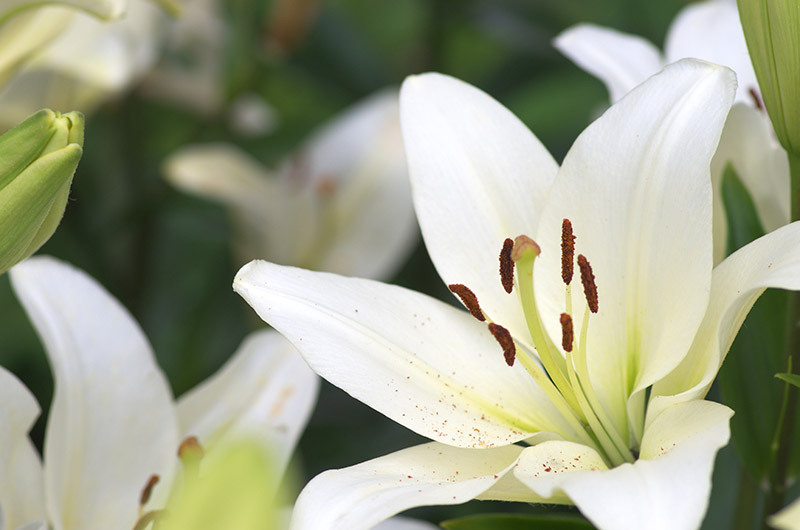Maximizing Poinsettia Longevity
Posted on 17/08/2025
Maximizing Poinsettia Longevity: A Comprehensive Guide
Poinsettias are synonymous with the festive season, gracing homes, offices, and public spaces with their vibrant red, pink, or creamy white bracts. However, many people struggle to keep these beautiful plants thriving beyond the holiday season. If you're interested in maximizing poinsettia longevity and enjoying your plant's colorful display well after the New Year, this guide will provide you with detailed, expert-approved strategies for success.

Understanding Your Poinsettia
The first step in ensuring a long and healthy life for your poinsettia is understanding its biology and environmental needs. Native to Mexico, Euphorbia pulcherrima is a perennial shrub in its natural habitat. Under the right conditions, poinsettias can last throughout the year and even bloom again the following season.
- Botanical name: Euphorbia pulcherrima
- Common Names: Poinsettia, Christmas Star, Mexican Flame Leaf
- Native Habitat: Tropical and subtropical regions of Central America
- Main Challenge: Maintaining vibrant bracts and healthy foliage over time
The Fundamentals of Poinsettia Care
1. Selecting a Healthy Poinsettia
The longevity of your poinsettia starts at the point of purchase. Choose a plant that already shows signs of vitality:
- Dark green leaves
- Tightly clustered, beady yellow flowers (the true flowers, called cyathia, at the branch tips)
- Bracts (the colored leaves) that are vibrant and unblemished
- No signs of wilting, yellowing, or leaf drop
Tip: Avoid plants displayed near store entrances or exits where they may be exposed to cold drafts. Sudden temperature changes can stress poinsettias and diminish their longevity.
2. Ideal Placement at Home
Where you place your poinsettia is crucial for its survival and vigor. Maximize your poinsettia's lifespan by considering these points:
- Light: Poinsettias require bright, indirect light. A sunny east- or west-facing window is ideal, but avoid direct sun, which can scorch the bracts and leaves.
- Temperature: Aim for a consistent indoor temperature between 60° and 70°F (15-21°C). Fluctuations or exposure to cold drafts and hot air (from heaters or appliances) can stress your plant.
- Humidity: Poinsettias prefer moderate humidity levels. In drier homes, occasional misting or placing a humidifier nearby can help prevent leaf drop.
Remember: Never let the leaves touch cold window panes, as this can cause damage.
3. Watering Your Poinsettia Correctly
Watering is perhaps the most critical factor for extending poinsettia longevity. Both overwatering and underwatering can be detrimental. For maximized poinsettia life span, follow these watering guidelines:
- Check the soil regularly. Water when the top inch of soil feels dry to the touch.
- Ensure the plant pot has ample drainage to prevent root rot. Remove decorative foil or poke holes if necessary.
- Water thoroughly but do not allow the pot to sit in excess water.
- Reduce watering frequency after the holiday display and during the dormant period (late winter to early spring).
Tip: If you see wilted leaves or soggy soil, reassess your watering schedule immediately to ensure poinsettia survival.
Advanced Tips for Maintaining Poinsettia Health
1. Feeding Your Poinsettia
During the bract display period (November through January), poinsettias generally do not require fertilization. Begin feeding your plant once new growth appears in late winter or early spring:
- Use a balanced, all-purpose houseplant fertilizer (such as 20-20-20), diluted to half strength.
- Feed every 4-6 weeks during active growth (spring to early autumn).
- Cease fertilizing in the weeks leading up to expected color change (late fall), to focus energy on blooming.
2. Pruning and Pinching Back
Pruning is essential for maximizing poinsettia longevity and encouraging dense, attractive growth:
- After bracts fade (typically in March or April), prune the plant back to 6 inches above the soil.
- Pinch back new growth as it develops, leaving 2-3 leaves per stem to encourage branching.
- Repeat pinching monthly until late summer for a compact, bushy plant.
Tip: Always wear gloves and wash hands afterward, as poinsettia sap can irritate the skin.
3. Repotting Your Poinsettia
You can further extend poinsettia life by repotting:
- Repot in spring after pruning, using well-draining, peat-based potting mix.
- Choose a pot that is 1-2 inches larger in diameter than the original.
- Water thoroughly after repotting and maintain consistent moisture (not soggy!) in the following weeks.
Poinsettia Reblooming: Extending the Display Across Seasons
Understanding Photoperiodism
Poinsettias are short-day plants, which means they require extended periods of darkness to trigger the color change in their bracts. To encourage reblooming and further maximize the lifespan of your poinsettia, follow these steps:
- Starting in late September or early October, provide complete darkness for at least 14 hours per night. Cover the plant with a box or place in a dark closet from approximately 5 p.m. to 8 a.m.
- During the day, return the plant to a bright location for at least 6 hours of indirect sunlight.
- Repeat this cycle for approximately 8-10 weeks. Any stray light during the "dark" period can interrupt the process.
- Once bracts begin to color, resume normal care and enjoy your poinsettia well into the winter!
Common Reblooming Challenges
- Accidental light exposure during dark hours (causing erratic blooming)
- Insufficient daylight during the day phase
- Poor plant health due to improper care earlier in the year
Persistence and attention to detail are the keys to successful reblooming, turning your poinsettia into a perennial holiday favorite.
Protecting Poinsettias from Pests and Problems
Common Poinsettia Issues
Even with the best care, poinsettias can encounter health challenges. To maximize poinsettia longevity, monitor for:
- Yellowing leaves: Often a symptom of overwatering or poor drainage.
- Wilting: Can result from underwatering or root rot; check soil moisture and drainage.
- Dropped leaves: Stress due to temperature changes, drafts, or low humidity.
- Insect pests: Look out for whiteflies, spider mites, or aphids. Treat infestations promptly with insecticidal soap or neem oil.
Quick Fixes for Healthy, Long-Lasting Poinsettias
- Isolate infected plants immediately to prevent spread.
- Adjust environmental conditions to optimal ranges (temperature, light, humidity).
- Regularly inspect your plant for early signs of trouble.
- Wipe bracts and leaves gently with a damp cloth to reduce dust and pests.
Poinsettia FAQ: Maximizing Plant Longevity
How long do poinsettias last?
In ideal conditions, poinsettia bracts can remain colorful for four to six months, while the plant itself can live for many years with proper care and regular repotting. Following the steps above, maximizing the longevity of poinsettias in your home is a realistic goal.
Can poinsettias be kept outside?
Poinsettias can thrive outdoors in USDA zones 9-11, where temperatures stay above 50°F (10°C). In cooler regions, shift your plant outdoors in late spring and bring it back inside before temperatures drop in autumn. Always acclimate gradually to avoid shock.
Are poinsettias toxic?
Contrary to popular myth, poinsettias are only mildly toxic to pets and humans. Ingestion may cause mild stomach upset, and the sap can irritate the skin. Keep them out of reach of pets and children, and always handle with care.
Why are my poinsettia leaves turning yellow and falling off?
This symptomatic of environmental stress, usually due to overwatering, underwatering, or sudden changes in temperature. Reevaluate your care routine and modify accordingly.
Long-Term Poinsettia Care Calendar
- January - March: Continue regular care as bracts fade. Reduce watering as plant enters semi-dormancy.
- April: Prune plant back to 6 inches. Resume feeding and begin more frequent watering as new growth emerges.
- May - September: Allow plant to enjoy bright, indirect light. Repot if needed. Move outdoors in warm climates.
- Late September - November: Begin photoperiod treatment for reblooming.
- November - December: Return to regular indoor care, enjoy colorful bracts for the festive season.

Summary: Prolonging the Life of Your Poinsettia
Maximizing poinsettia longevity is more than just a seasonal pursuit--it's about understanding your plant's needs throughout the year. From smart purchasing and proper placement to careful watering, regular feeding, pruning, and providing the right amount of light, each step makes a difference. With patience and commitment, your poinsettia can become a long-lived household companion and a yearly highlight of your home decor.
Remember: A thriving poinsettia brings color, cheer, and beauty long beyond the holiday season. With the right care techniques, you can enjoy its stunning display for many years to come.
Key Takeaways for Maximizing Poinsettia Longevity
- Select healthy plants with vibrant bracts at purchase
- Provide bright, indirect light and maintain stable temperatures between 60-70°F
- Water only when the soil is dry one inch below the surface, and ensure proper drainage
- Feed with balanced fertilizer during the growing season
- Prune and pinch for bushier growth after the colorful bracts fade
- Follow the photoperiod process for reblooming in the next season
- Monitor for pests and problems, and react quickly if any are found
By following these expert strategies, you can extend the life of your poinsettia, keeping your home vibrant and festive, season after season.
Latest Posts
Maximizing Poinsettia Longevity
Unlocking the Secrets to Vibrant Hydrangeas
Peony Flowers' Symbolic Significance and the Meaning of Their Colors
Unlock the beauty and meanings of birth month flowers
The Love Language of Red Roses in Valentine's Day Celebrations






